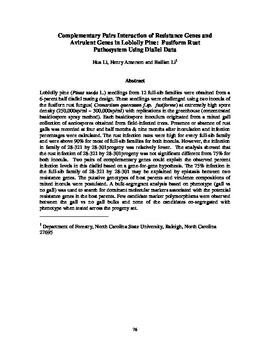| dc.contributor.author | Li, H. | |
| dc.contributor.author | Amerson, H. | |
| dc.contributor.author | Li, B. | |
| dc.date.accessioned | 2016-04-25T19:35:58Z | |
| dc.date.available | 2016-04-25T19:35:58Z | |
| dc.date.issued | 2003 | |
| dc.identifier | oksd_sf27_p076.pdf | |
| dc.identifier.citation | Li, H., Amerson, H., & Li, B., (2003). "Complementary Pairs Interaction of Resistance Genes and Avirulent Genes in Loblolly Pine: Fusiform Rust Pathosystem Using Diallel Data." In 27th Southern Forest Tree Improvement Conference, Stillwater, OK | |
| dc.identifier.uri | https://hdl.handle.net/11244/33666 | |
| dc.description.abstract | Loblolly pine (Pinus taeda L.) seedlings from 12 full-sib families were obtained from a 6-parent half diallel mating design. These seedlings were challenged using two inocula of the fusiforn rust fungus( Cronartium quercuum f.sp. fusiforme) at extremely high spore density (250,000sp/ml ~ 300,000sp/ml) with replications in the greenhouse (concentrated basidiospore spray method). Each basidiospore inoculum originated from a mixed gall collection of aeciospores obtained from field-infected trees. Presence or absence of rust galls was recorded at four and half months & nine months after inoculation and infection percentages were calculated. The rust infection rates were high for every full-sib family and were above 90% for most of full-sib families for both inocula. However, the infection in family of 28-321 by 28-301progeny was relatively lower. The analysis showed that the rust infection of 28-321 by 28-301progeny was not significant different from 75% for both inocula. Two pairs of complementary genes could explain the observed percent infection levels in this diallel based on a gene-for-gene hypothesis. The 75% infection in the full-sib family of 28-321 by 28-301 may be explained by epistasis between two resistance genes. The putative genotypes of host parents and virulence compositions of mixed inocula were postulated. A bulk-segregrant analysis based on phenotype (gall vs no gall) was used to search for dominant molecular markers associated with the potential resistance genes in the host parents. Few candidate marker polymorphisms were observed between the gall vs no gall bulks and none of the candidates co-segregated with phenotype when tested across the progeny set. | |
| dc.format | application/pdf | |
| dc.language | en_US | |
| dc.relation.ispartofseries | Sponsored publication . . . of the Southern Forest Tree Improvement Committee ; no. 49 | |
| dc.rights | This paper is made available through open access and the auspices of the fair use doctrine for scholarly, educational and research purposes while recognizing the publisher already offers a free online version. The OSU Library�s intent is to offer access and preserve publications involving its faculty contributions. Contact the Digital Resources and Discovery Services at lib-dls@okstate.edu or 405-744-9161 for the permission policy on the use, reproduction or distribution of this material. | |
| dc.source | Proceedings of the 27th Southern Forest Tree Improvement Conference, volume 27, 2003. Editor, Craig R. McKinley. | |
| dc.title | Complementary Pairs Interaction of Resistance Genes and Avirulent Genes in Loblolly Pine: Fusiform Rust Pathosystem Using Diallel Data | |
| dc.type | text | |
| osu.filename | oksd_sf27_p076.pdf | |
| dc.type.genre | Conference proceedings | |
| dc.description.scopeandcontents | Papers and abstracts from the 27th Southern Forest Tree Improvement Conference held at Oklahoma State University in Stillwater, Oklahoma on June 24-27, 2003. | |
